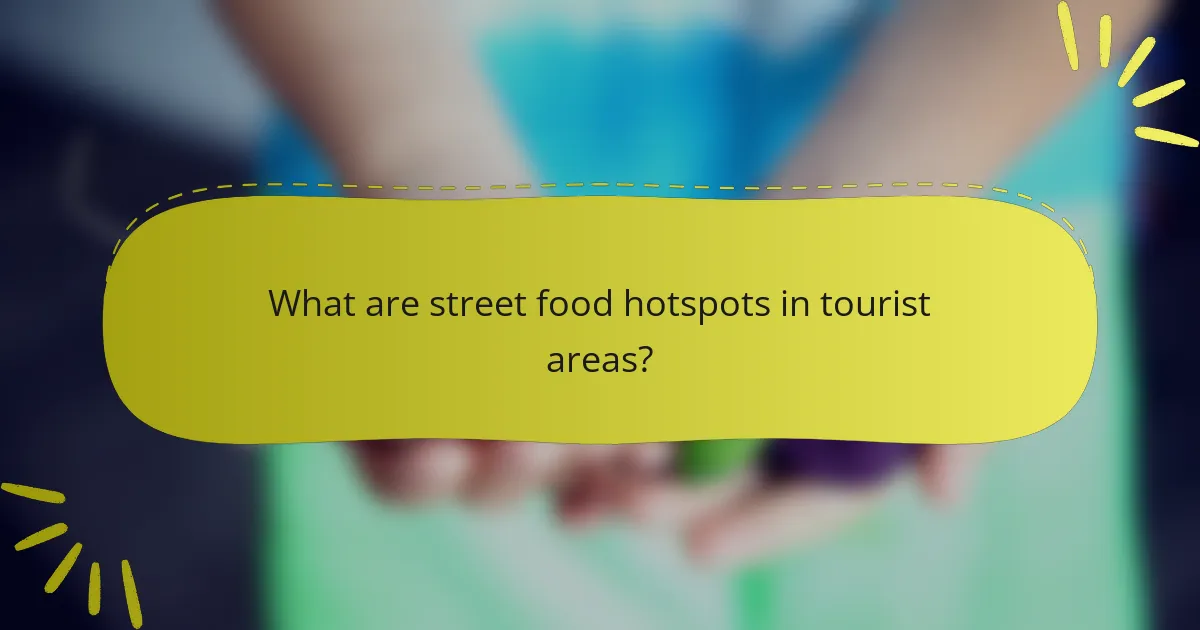Street food hotspots in tourist areas are locations renowned for their vibrant culinary scenes and diverse food offerings, such as Bangkok’s Chatuchak Market, Mexico City’s Mercado de San Juan, and Hanoi’s Old Quarter. These areas provide visitors with authentic local flavors, featuring popular dishes like pad Thai, tacos al pastor, and pho. Street food not only enhances cultural immersion but also supports local economies by providing income to vendors and promoting community engagement. Visitor feedback highlights the affordability, freshness, and social atmosphere of these hotspots, making them a favored choice for tourists seeking unique dining experiences.

What are street food hotspots in tourist areas?
Street food hotspots in tourist areas include locations like Bangkok’s Chatuchak Market, Mexico City’s Mercado de San Juan, and Hanoi’s Old Quarter. These areas are known for their vibrant food scenes and diverse offerings. In Bangkok, visitors can enjoy dishes like pad Thai and mango sticky rice. Mexico City offers tacos al pastor and tamales. Hanoi is famous for pho and banh mi. These hotspots attract tourists due to their authentic flavors and cultural experiences. Additionally, they often receive positive feedback for affordability and variety. The unique atmosphere enhances the overall dining experience for visitors.
Why are street food hotspots popular among tourists?
Street food hotspots are popular among tourists due to their unique culinary experiences. Tourists seek authentic local flavors that reflect the culture of the area. Street food offers diverse options at affordable prices, appealing to budget-conscious travelers. The vibrant atmosphere of street markets enhances the overall dining experience. Many tourists enjoy the social aspect of eating among locals and fellow travelers. Street food also provides quick meal options, ideal for those exploring new destinations. According to a study by the World Street Food Congress, over 70% of travelers prioritize street food as a must-try experience. This trend showcases the integral role of street food in the tourism industry.
What factors contribute to the appeal of street food hotspots?
Street food hotspots appeal due to their vibrant atmosphere, diverse food options, and affordability. The lively environment attracts both locals and tourists, creating a sense of community. A wide variety of dishes showcases regional flavors and culinary traditions. This diversity allows visitors to experience authentic local cuisine. Additionally, street food is generally more affordable than dining in restaurants, making it accessible to a broader audience. The convenience of quick service caters to tourists seeking a fast meal during their explorations. High foot traffic in tourist areas enhances visibility and draws in more customers. Overall, these factors create a unique dining experience that is both enjoyable and memorable.
How do street food hotspots enhance the tourist experience?
Street food hotspots enhance the tourist experience by providing authentic local cuisine. Tourists can taste traditional dishes that reflect the culture of the area. These hotspots often feature vibrant atmospheres, encouraging social interaction among visitors. They also offer affordable dining options, making it accessible for travelers on a budget. Additionally, street food vendors frequently use fresh, local ingredients, ensuring high-quality meals. According to a study by the World Food Travel Association, 93% of travelers consider food experiences essential to their trips. This statistic highlights the importance of street food in enhancing overall satisfaction for tourists.
Where can street food hotspots be found in popular tourist destinations?
Street food hotspots can be found in various popular tourist destinations around the world. Cities like Bangkok, Thailand are renowned for their vibrant street food scene. In Bangkok, vendors line the streets offering dishes like Pad Thai and Som Tum. Another hotspot is Mexico City, where street food includes Tacos al Pastor and Elotes. In New York City, food trucks and stands serve iconic items like hot dogs and pretzels. Additionally, Hanoi, Vietnam is famous for its Pho and Banh Mi available at street stalls. Each of these cities attracts millions of tourists who seek authentic local flavors.
What are some notable street food hotspots in major cities?
Notable street food hotspots in major cities include Bangkok’s Chatuchak Market, known for its diverse offerings. In Mexico City, the streets are filled with taco stands that serve authentic flavors. New York City boasts food trucks like The Halal Guys, popular for their chicken and rice platters. In Mumbai, Juhu Beach is famous for its bhel puri and vada pav. Tokyo’s street food scene features yakitori stalls in areas like Omoide Yokocho. Each of these locations attracts tourists and locals alike, offering unique culinary experiences.
How do local cultures influence the location of street food hotspots?
Local cultures significantly influence the location of street food hotspots. Cultural preferences shape the types of food available and the settings in which they are served. For example, in regions with a strong tradition of communal dining, street food often thrives in areas with high foot traffic. Festivals and local events also create temporary hotspots, reflecting cultural celebrations. Furthermore, cultural attitudes towards food safety and hygiene can determine where vendors set up. In countries with a vibrant street food culture, such as Thailand, vendors are often found in bustling markets or near tourist attractions. This strategic placement caters to both locals and visitors, enhancing the street food experience.

What are the benefits of street food hotspots in tourist areas?
Street food hotspots in tourist areas provide diverse culinary experiences. They offer authentic local flavors that enhance cultural immersion for visitors. These hotspots often feature quick and affordable meal options, catering to various budgets. They create vibrant social atmospheres, encouraging interaction among tourists and locals. Additionally, street food supports local economies by providing income to vendors. According to a study by the World Bank, street food contributes significantly to urban employment and tourism revenue. Furthermore, these hotspots can reduce food waste by utilizing local ingredients. Overall, street food hotspots enrich the tourist experience while promoting community engagement.
How do street food hotspots support local economies?
Street food hotspots support local economies by generating income and creating jobs. They provide affordable dining options that attract both locals and tourists. This influx of visitors boosts sales for food vendors, increasing their revenue. According to a study by the World Bank, street food contributes significantly to urban employment. Additionally, these hotspots often source ingredients from local farmers and suppliers. This practice stimulates local agriculture and supports small businesses. Street food also enhances the cultural identity of an area, encouraging tourism. Overall, street food hotspots play a vital role in economic development.
What economic impact do street food vendors have on communities?
Street food vendors significantly contribute to local economies by creating jobs and generating income. They provide affordable food options, attracting both locals and tourists. This increased foot traffic benefits surrounding businesses as well. According to a study by the International Journal of Hospitality Management, street vendors can enhance local economic activity by 20-30%. Additionally, they often source ingredients from local suppliers, further stimulating the community’s economy. Their presence can also lead to urban revitalization, making areas more vibrant and appealing. Overall, street food vendors play a crucial role in economic development within communities.
How do street food hotspots create job opportunities?
Street food hotspots create job opportunities by attracting both vendors and support staff. These locations often require food preparation, cooking, and serving personnel. Additionally, they generate demand for roles in marketing, logistics, and maintenance. For instance, a study by the Food and Agriculture Organization noted that street food vendors can employ multiple staff members, enhancing local employment rates. Furthermore, the presence of street food can boost tourism, leading to increased economic activity and further job creation in surrounding businesses. This interconnectedness fosters a vibrant local economy, contributing to sustainable job growth.
What advantages do tourists gain from visiting street food hotspots?
Tourists gain diverse culinary experiences from visiting street food hotspots. These locations offer authentic local flavors that reflect cultural heritage. Street food is often more affordable than dining in restaurants. Tourists can sample a variety of dishes in one area. This allows for exploration of different cuisines without significant commitment. Additionally, street food hotspots often foster social interactions among locals and tourists. Engaging with vendors provides insights into local traditions and cooking methods. A study by the World Food Travel Association highlights that 80% of travelers seek food experiences as part of their journey. This trend emphasizes the importance of street food in enhancing overall travel satisfaction.
How do street food hotspots provide authentic culinary experiences?
Street food hotspots provide authentic culinary experiences by showcasing local flavors and traditional cooking methods. They often feature dishes that reflect the region’s culture and history. Vendors frequently use fresh, locally sourced ingredients, enhancing the authenticity of the food. The preparation methods can include grilling, frying, or steaming, which are commonly practiced in the local cuisine. Street food markets also create a vibrant atmosphere, allowing visitors to engage with local chefs and learn about the dishes. According to a study by the World Food Travel Association, 83% of travelers seek authentic food experiences during their trips. This indicates a strong demand for the unique offerings found in street food hotspots.
What is the role of street food in cultural exchange for tourists?
Street food plays a significant role in cultural exchange for tourists. It provides an authentic experience of local cuisines and traditions. Tourists engage with local vendors, fostering communication and cultural understanding. Street food often reflects regional ingredients and cooking methods, showcasing the area’s culinary heritage. According to a study by the World Food Travel Association, 80% of travelers believe food experiences are essential for cultural immersion. This highlights the importance of street food in promoting cultural exchange. Additionally, street food markets often serve as social hubs, where tourists and locals interact, further enhancing cultural sharing.

What are the popular dishes found at street food hotspots?
Popular dishes at street food hotspots include tacos, dumplings, and satay. Tacos are often filled with various meats, beans, and vegetables, making them a versatile choice. Dumplings can be steamed or fried and come with a variety of fillings, appealing to many tastes. Satay consists of skewered and grilled meat, typically served with a peanut sauce, and is a favorite in Southeast Asia. Other popular options include falafel, which is made from ground chickpeas and spices, and is commonly served in pita bread. Additionally, street food hotspots often feature local specialties, such as banh mi in Vietnam and arepas in Colombia, showcasing regional flavors. These dishes are not only popular among locals but also attract tourists seeking authentic culinary experiences.
What types of cuisine are typically offered at street food hotspots?
Street food hotspots typically offer a variety of cuisines, reflecting local and international flavors. Common types include Asian cuisines such as Thai, Vietnamese, and Chinese. Latin American options often feature tacos, empanadas, and arepas. Middle Eastern street food includes falafel, shawarma, and kebabs. European offerings can range from crepes to Italian pizza. These cuisines are popular due to their affordability and accessibility. Street food often emphasizes fresh ingredients and bold flavors. The diversity of options caters to different tastes and preferences.
How do regional specialties vary across different tourist areas?
Regional specialties vary significantly across different tourist areas due to local ingredients and cultural influences. Each region’s climate affects the availability of fresh produce and meats. For example, coastal areas often feature seafood prominently in their specialties. In contrast, inland regions may focus on meats and grains. Historical trade routes also influence local flavors and cooking techniques. Regions with diverse cultural backgrounds showcase a blend of culinary traditions. Tourist areas may adapt these specialties to cater to international tastes. Popular dishes often reflect local heritage and seasonal ingredients, enhancing their uniqueness.
What are some must-try dishes at popular street food locations?
Tacos al pastor are a must-try dish at popular street food locations in Mexico City. They feature marinated pork cooked on a vertical spit. This cooking method is influenced by Lebanese shawarma. Another popular dish is pad thai from street vendors in Bangkok. It combines stir-fried rice noodles with shrimp, tofu, and peanuts. In addition, banh mi is a popular Vietnamese sandwich found in Ho Chi Minh City. It includes a crispy baguette filled with meats and pickled vegetables. Lastly, falafel from street stalls in Jerusalem is highly recommended. These deep-fried chickpea balls are often served in pita bread with vegetables and sauce. Each dish reflects the local culture and culinary traditions.
How do food trends influence street food offerings in tourist areas?
Food trends significantly influence street food offerings in tourist areas. As tourists seek unique culinary experiences, vendors adapt their menus to reflect current trends. For instance, the rise of plant-based diets has led to an increase in vegan street food options. Additionally, global food trends, such as fusion cuisine, encourage vendors to combine traditional recipes with international flavors. Social media also plays a pivotal role, as visually appealing dishes gain popularity online. Consequently, vendors create Instagram-worthy food items to attract tourists. Research indicates that 70% of travelers are influenced by food trends when choosing destinations. Thus, street food offerings evolve to meet the demands of trend-conscious tourists.
What innovative dishes have emerged from street food culture?
Innovative dishes that have emerged from street food culture include gourmet food trucks offering fusion tacos and artisanal burgers. These dishes often blend traditional recipes with modern culinary techniques. For example, Korean BBQ tacos combine marinated beef with Mexican tortillas. Another example is the rise of bao buns filled with diverse ingredients like fried chicken or vegan options. Street vendors have also popularized unique desserts, such as mochi ice cream and gourmet doughnuts. These innovations reflect a growing trend of creativity and experimentation in street food. The success of these dishes can be seen in their popularity at food festivals and urban markets worldwide.
How do dietary preferences shape the menu at street food hotspots?
Dietary preferences significantly influence the menu at street food hotspots. Vendors adapt their offerings to meet the diverse needs of customers. Popular dietary trends include vegan, vegetarian, gluten-free, and organic options. Research indicates that 39% of consumers actively seek out plant-based meals. Street food vendors often highlight local ingredients to attract health-conscious diners. Seasonal and regional specialties also cater to specific dietary preferences. Additionally, customer feedback shapes menu changes to enhance satisfaction. Data shows that menus reflecting dietary trends can increase sales by up to 30%. Thus, dietary preferences are crucial in shaping street food menus to attract a wider audience.

What feedback do visitors provide about street food hotspots?
Visitors often provide positive feedback about street food hotspots. They appreciate the variety of flavors and cuisines available. Many highlight the affordability of the food as a major advantage. Freshness and quality of ingredients are frequently praised. Visitors also enjoy the vibrant atmosphere surrounding these food stalls. Convenience and accessibility are noted as key benefits. Social interactions with vendors enhance the overall experience. Some visitors mention long wait times as a minor drawback. Overall, the feedback emphasizes enjoyment and satisfaction with street food experiences.
How do tourists rate their experiences at street food hotspots?
Tourists generally rate their experiences at street food hotspots positively. Many travelers appreciate the authenticity and local flavors offered at these venues. A survey by the World Food Travel Association found that 75% of tourists consider food experiences critical to their travel satisfaction. Additionally, street food is often viewed as an affordable and convenient option. Tourists frequently highlight the vibrant atmosphere and social interactions as key benefits. Many reviews on travel platforms emphasize the unique culinary experiences that street food provides. Overall, these factors contribute to a favorable rating of street food hotspots among tourists.
What common themes emerge in visitor reviews of street food?
Common themes in visitor reviews of street food include taste, affordability, and variety. Reviewers often highlight the exceptional flavors of the dishes. Many express satisfaction with the prices, noting that street food offers great value. Variety is frequently mentioned, as visitors appreciate the diverse options available. Cleanliness is also a recurring theme, with some reviews emphasizing the importance of hygiene. Additionally, the atmosphere of street food markets often garners positive feedback. Many visitors enjoy the social experience of eating among locals and other tourists. Convenience and accessibility are often praised, as street food is typically easy to find in tourist areas. Overall, these themes reflect visitor preferences and experiences related to street food.
How can feedback from visitors improve street food offerings?
Feedback from visitors can significantly improve street food offerings by providing insights into customer preferences. This feedback helps vendors understand which dishes are popular and which may need adjustments. Specific comments can highlight desired flavors, portion sizes, or ingredient quality. Vendors can use this information to refine recipes and enhance overall taste. Additionally, feedback can reveal trends in dietary preferences, such as increased demand for vegetarian or gluten-free options. By adapting to these trends, vendors can attract a broader audience. Research shows that food businesses that engage with customer feedback often see increased sales and repeat customers. Therefore, actively seeking and implementing visitor feedback leads to better street food offerings.
What tips can tourists follow to enhance their street food experience?
To enhance their street food experience, tourists should prioritize cleanliness when choosing food vendors. Observing the vendor’s hygiene practices can help ensure food safety. Tourists should also try to eat where locals eat, as this often indicates quality and authenticity. Engaging with vendors can provide insights into the dishes and ingredients used. Sampling small portions from various stalls allows tourists to experience a wider range of flavors. Timing is important; visiting during peak hours can ensure fresher food. Tourists should also be open to trying unfamiliar dishes, as this can lead to discovering new favorites. Finally, staying hydrated is crucial, especially in warm climates, to fully enjoy the culinary adventure.
How can tourists choose safe and high-quality street food options?
Tourists can choose safe and high-quality street food options by observing vendor cleanliness and food preparation practices. Look for stalls with a high turnover of customers, as this indicates freshness. Vendors who maintain clean workspaces and wear gloves demonstrate good hygiene. Additionally, choosing cooked foods over raw items reduces the risk of foodborne illnesses. Familiarity with local food safety standards can guide choices. Research shows that popular street food markets often have regulations ensuring vendor compliance with health codes. For instance, the World Health Organization advocates for proper food handling to prevent contamination.
What strategies can enhance the enjoyment of street food exploration?
To enhance the enjoyment of street food exploration, travelers should prioritize local recommendations. Engaging with locals can provide insights into the best vendors and hidden gems. Additionally, exploring during peak hours maximizes the variety and freshness of offerings. Trying a small portion from multiple vendors allows for a broader tasting experience. Embracing cultural customs related to street food can deepen appreciation. Research shows that social dining experiences, such as sharing food with friends, increase enjoyment. Finally, maintaining an open mind towards unfamiliar flavors can lead to delightful surprises.
Street food hotspots in tourist areas serve as vibrant locations where travelers can experience authentic local cuisine, diverse offerings, and cultural immersion. Popular destinations include Bangkok’s Chatuchak Market, Mexico City’s Mercado de San Juan, and Hanoi’s Old Quarter, each featuring unique dishes that reflect regional flavors. These hotspots are favored for their affordability, quick service, and social atmosphere, enhancing the overall tourist experience. Visitor feedback highlights the appeal of variety, taste, and cleanliness, while local vendors contribute to economic development through job creation and community engagement. The article explores the benefits, popular dishes, and factors influencing the popularity of street food in tourist areas.